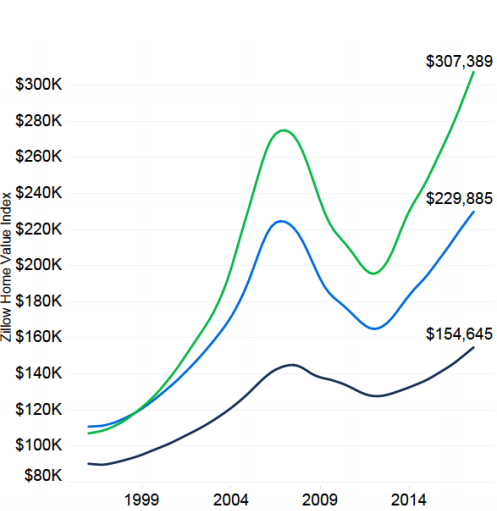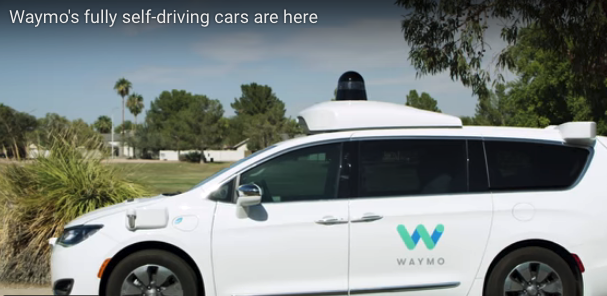What City Observatory did this week
1. The growing premium for urban living. Three years ago, City Observatory introduced the term “the Dow of cities.” In essence, its the observation that the growth in city home prices relative to suburban ones is a good indicator of the relative value that people attach to urban living. And the data show a clear bull market for cities. The latest figures come from Zillow; their house price data show that prices for urban homes have far outstripped those in suburban areas, and the gap between the two continues to widen. Today, the typical urban home is worth almost a third more than the average suburban home. It’s strong evidence that there’s a continuing demand for urban living and shows that we have a shortage of cities.
2. Can we finally put an end to the housing supply debate? It’s a widely held view that building more market rate housing in cities somehow produces greater displacement, but that’s been debunked both by economic theory and practical experience. While some affordable housing advocates are arguing for more “trickle up housing” as a solution, the studies they cite actually show that market rate housing has a powerful, positive effect in reducing displacement. Building two new market rate housing units has nearly the same effect in reducing displacement as building a single affordable housing unit. And the key is market rate housing can be expanded at much lower cost; provided we have the policies that incentivize and allow more housing to be built where there is market demand.
Must read
1. Fires aren’t the only thing ravaging the California economy. UC Berkeley economist Enrico Moretti, writing in the New York Times argues that many of the Golden State’s problems–from inequality to the wildfire damage to sprawling suburban subdivisions–can be traced to a set of policies that cumulatively block the provision of housing in cities where its most needed. San Francisco continues to generate new jobs at a rate that far outstrips the increase in housing, largely because it has made building more densely so difficult and expensive. The result: the Bay Area has sprawled further and further, and at the margins intersects with ecologically sensitive (and fire prone) areas. Promoting more urban density would both increase economic opportunity, and benefit the environment.
2. Fully self-driving cars are here now (at least in Phoenix). Google autonomous vehicle subsidiary Waymo has announced that its deploying fully-self driving cars–vehicles with no stand-by human driver in Phoenix. From Waymo’s description it sounds like these vehicles have level 4 autonomy (driverless, but in a limited area) with initial deployment in suburban Chandler. As Waymo says: “Starting now, Waymo’s fully self-driving vehicles are test driving on public roads, without anyone in the driver’s seat. To date, Waymo vehicles have been operating on public roads with a test driver at the wheel. Now, in an area of the Phoenix metro region, a subset of our fleet will operate in fully autonomous mode, with Waymo as the sole driver.” The deployment of autonomous vehicles is happening faster than many thought possible, and in an environment with limited government regulation.
3. Why Uber (and autonomous vehicles) can’t solve urban congestion. Streetsblog’s Angie Schmidt has a very insightful take on the inadvertent message in a new add by Uber. The add depicts a crowded Singapore Street with each person in a separate cardboard box. The implication, per Angie: “By stripping away the gloss, anonymity, and cultural connotations of car exteriors and leaving only their bulk, the ad brilliantly highlights why moving around in single-occupancy vehicles is so absurd in an urban context. There’s just not enough space for everyone to get around this way.” The image tells the story:
New knowledge
Community-based non-profits helped reduce crime. A new paper from Patrick Sharkey and co-authors–investigates the connection between community organizations and crime rates. While there have been many theories posited for the dramatic decline in crime rates in most US cities over the past 20 years, including more extensive policing, declines in lead levels, and other factors, Sharkey looks specifically at community based non-profits. Using data from the National Center for Charitable Statistics (NCCS), he finds that “every 10 additional organizations focusing on crime and community life in a city with 100,000 residents leads to a 9 percent reduction in the murder rate, a 6 percent reduction in the violent crime rate, and a 4 percent reduction in the property crime rate.” Their more detailed analysis suggests that the biggest impacts were a result of non-profits focusing on substance abuse and workforce development. (Hat tip to NYT’s Emily Badger).
In the news
The Washington Post takes the recent attack on Senator Rand Paul–who had three ribs broken by a neighbor who assaulted him over a dispute about appropriate yard-care practices in their gated subdivision–as evidence of the decline in social capital we explored in our report Less in Common. The Post quotes City Observatory’s Joe Cortright as saying: “Space and experiences became more private, fueled by suburban expansion, large lots, and the predominance of single-family homes.”
Human Transit‘s Jarrett Walker highlighted our recent story on the profusion of “FOR RENT” signs in Portland, confirming that building market rate housing influences the rents paid by everyone in the community.




